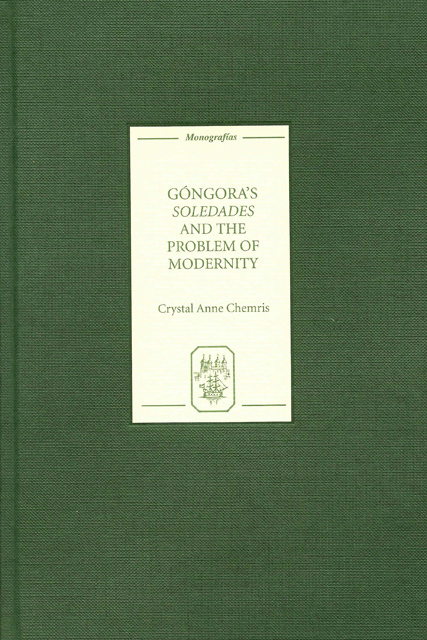Book contents
- Frontmatter
- Contents
- Dedication
- Foreword
- Acknowledgments
- Preface
- Introduction: Renaissance and Solitude
- 1 Crisis and Form
- 2 Violence, Eros and Lyric Emotion
- 3 Self and World: The Crisis of Perception in the Soledades
- 4 Time, Space and Apocalypse: The Falconry Scene as Disruption of Prophecy
- 5 Góngora and the Modern: “New Poetry”?
- Works Cited
- Index
4 - Time, Space and Apocalypse: The Falconry Scene as Disruption of Prophecy
Published online by Cambridge University Press: 03 May 2023
- Frontmatter
- Contents
- Dedication
- Foreword
- Acknowledgments
- Preface
- Introduction: Renaissance and Solitude
- 1 Crisis and Form
- 2 Violence, Eros and Lyric Emotion
- 3 Self and World: The Crisis of Perception in the Soledades
- 4 Time, Space and Apocalypse: The Falconry Scene as Disruption of Prophecy
- 5 Góngora and the Modern: “New Poetry”?
- Works Cited
- Index
Summary
En Signorelli, sólo hay tiempo, o más bien, un tiempo inasible en lucha con un espacio, como el universo mismo, en dilatación. La novedad es tan espantosa que el pintor, huérfano melancólico, se ve obligado a transformar ese tiempo y ese espacio en los del fin de todo tiempo y todo espacio: el apocalipsis, el juicio final.
Carlos Fuentes, Cervantes o la crítica de la lecturaThe breakdown in the boundaries of perception which arises out of the Baroque crisis of consciousness relates to an even more profound challenge to the sacerdotal, ordered worldview of the past. During the seventeenth century, the established perception of the very limits of time and space is called into question. The Baroque subject is stripped of a past sense of integration into the cosmos and faces the threat of dissolution in the indefinite expanse of the universe. Eternity and infinity seem to engulf him, and he projects his fear of self-dissolution onto the phenomenal world; he envisions the world engulfing itself. While Reformation theologians saw the portents of Apocalypse in the findings of the new astronomy, the intimation of Apocalypse is ultimately rooted in the Baroque response to the idea of infinity (Nicolson 119). As Frank J. Warnke states,
The popularity of the topos of the end of the world is based on a feature of sensibility more widespread than either devotional fervor or concern over the new science. It is [â¦] based on the expansive nature of the Baroque imagination as a whole, that feature [â¦] which stresses the unreality of the phenomenal world and, discontent with the classical conception of an ordered and enclosed world, is incapable of imagining a world without imagining also its dissolution. (214–15; see also Nicolson 177)
In its treatment of time, space, and the Baroque presentiment of Apocalypse, the Soledades is a true artefact of the consciousness of its age.
- Type
- Chapter
- Information
- Góngora's Soledades and the Problem of Modernity , pp. 87 - 103Publisher: Boydell & BrewerPrint publication year: 2007



